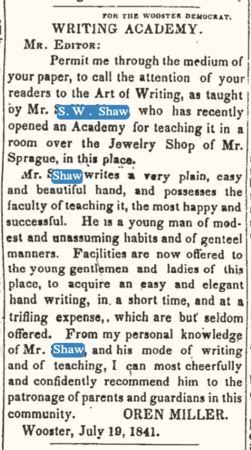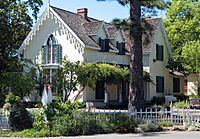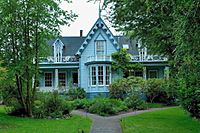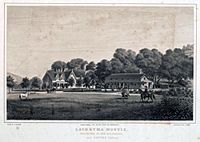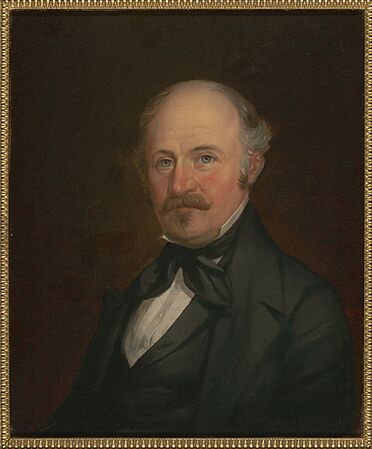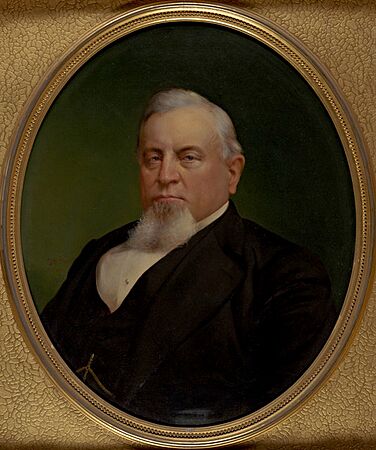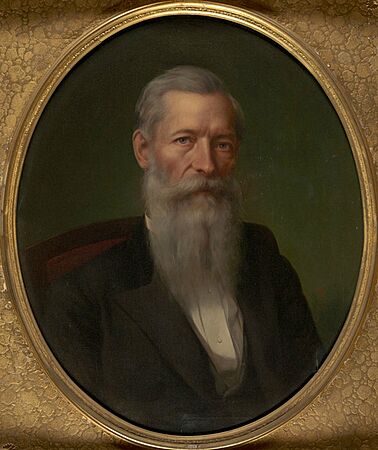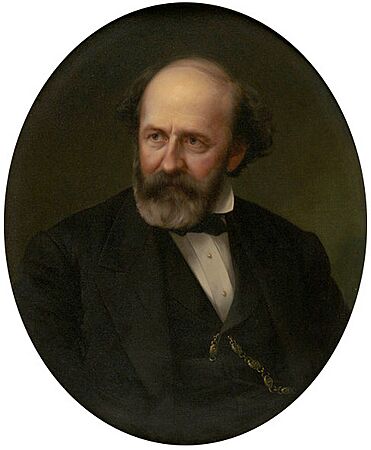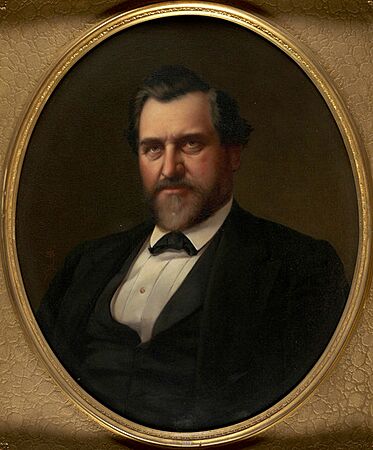Stephen William Shaw facts for kids
Stephen William Shaw (born December 15, 1817 – died February 12, 1900) was an American artist. He was a portrait painter who lived in California during the California Gold Rush in 1849. He also helped find and name Humboldt Bay and brought viticulture (grape growing for wine) to Sonoma County by 1864.
Contents
Stephen Shaw's Early Life and Art
Stephen W. Shaw was born in Windsor, Vermont, on December 15, 1817. His family were descendants of early American settlers and heroes of the American Revolution. When he was young, Shaw taught drawing and handwriting at Norwich Military Academy. He also taught art and directed the Boston Athenæum in Boston.
Later, he traveled around the southern United States as a portrait painter. This means he moved from place to place, painting people's pictures for money. In 1845, he painted his first oil portrait in Lexington, Kentucky. A year later, in Baton Rouge, he painted a portrait of General Zachary Taylor, who later became a U.S. President. This painting won a silver medal! In 1848, the City of New Orleans paid him $1,000 to paint a portrait of Persifer F. Smith. Shaw traveled to Veracruz and Mexico City to paint this picture.
Journey to California
In 1849, Shaw joined the California Gold Rush. He left New Orleans on a ship called Isthmus on April 21, 1849. He crossed the Panama land bridge, then got on another ship, the Alexander von Humboldt. This journey was very long and difficult. The ship was crowded, and there wasn't enough food. After more than three months, the ship finally arrived in San Francisco on August 30, 1849.
One of the other passengers was Collis Potter Huntington, who later became a famous railroad builder. He started a group called "The Society of the Humboldter" for the 365 people who survived the 102-day trip.
Stephen Shaw and many other passengers went straight to the gold mines near Mormon Island for about six months. Then, in early 1850, Shaw moved to Sacramento. There, he met Edwin B. Crocker, who would become a judge. Shaw painted more than 25 portraits of important Californians for Judge Crocker.
Discovering Humboldt Bay
In March 1850, Shaw left San Francisco on a ship called the Laura Virginia. On April 7, while near Trinidad, Shaw and four others were chosen to go ashore. Their mission was to find the entrance to Humboldt Bay from the land. They walked along the beach, crossed the Mad River with help from Native Americans, and camped near the bay's entrance.
On April 9, 1850, the ship's second mate, Hans Henry Buhne, successfully guided a small boat into Humboldt Bay. Later that day, more people and supplies were brought ashore. On April 14, the Laura Virginia itself sailed into the bay. Shaw drew the first pictures of the bay. He insisted that the bay be named after Alexander von Humboldt, a famous German scientist who studied nature. On April 26, 1850, a newspaper in San Francisco published a drawing based on Shaw's sketches of Humboldt Bay. Shaw returned to San Francisco in April 1851.
From Painting to Farming
In 1851, Shaw spent much of the year with John Sutter at his farm, Hock Farm, near the Feather River. He worked there as the family portrait painter and helped with business. After a short engagement to Sutter's daughter, Ann Eliza Sutter, Shaw went back to San Francisco.
Later that year, he and his brother Seth Shaw, along with Willard Allen, settled on Table Bluff near Loleta. In the summer of 1852, they moved across the Eel River and started clearing land where the town of Ferndale, California would later be built. During the very rainy winter of 1852–1853, many men stayed with the Shaws because their cabin was the most complete. Around 1852, Shaw painted a portrait of a Wiyot elder named Kiwelattah.
Shaw spent two years trying to grow plants in the cold, foggy coastal weather. But he didn't have much success. So, in 1854, Shaw returned to San Francisco. He later sold his land claim in Ferndale in 1856.
San Francisco Portrait Painter
Once back in San Francisco, Shaw quickly set up his art studio. He joined the Masons, a social and charitable group, on June 1, 1854. He painted over 200 portraits of Masonic officers, possibly using photographs. In 1860, Shaw won first prize for the best oil portrait at the California State Fair.
-
John Augustus Sutter, June 1851 by Stephen W. Shaw.
-
Charles Crocker, around 1872 by Stephen W. Shaw.
-
Mark Hopkins, Jr., around 1872 by Stephen W. Shaw.
-
Collis P. Huntington, around 1872 by Stephen W. Shaw.
-
Leland Stanford, around 1872 by Stephen W. Shaw.
-
Major General John McAllister Schoefield, 1874, by Stephen W. Shaw.
On April 18, 1861, Shaw married Mary Frances Meacham in San Francisco. Shaw also grew grapes and is known for bringing wine grape farming to Sonoma County. The Shaws had two children before Mary passed away on October 2, 1866. Shaw traveled abroad in 1871. When he returned to San Francisco, he married Lucretia Swain on August 12, 1873.
Stephen Shaw died on February 14, 1900, in San Francisco. His death was reported in the San Francisco Examiner newspaper on February 16, 1900.
Groups Stephen Shaw Belonged To
Shaw was a member of several important groups:
- The Masons
- The Society of California Pioneers
- The Bohemian Club
- The Mechanics' Institute
- The San Francisco Art Association
Stephen Shaw's Paintings and Writings
Many of Shaw's paintings were lost in the fires that followed the 1906 San Francisco earthquake. However, some of his works are still kept in museums and collections today. These include the Bancroft Library, the M. H. de Young Memorial Museum, the Fine Arts Museum of San Francisco, the Oakland Museum, the City of New Orleans, the Nantucket Historical Society, the Crocker Art Museum in Sacramento, The Ferndale Museum, The Clarke Historical Museum, and the Society of California Pioneers.
Shaw painted several family portraits, including his mother Elizabeth Barrett Shaw (around the 1860s) and his brother Sylvanus Harvey Shaw (both at the Ferndale Museum). He also painted his brother Seth Shaw (Ferndale's Masonic Temple). Shaw's family members still have other portraits, including one of Seth's wife Isabella Shaw, a small landscape painting, a self-portrait by Stephen Shaw, and his original farm record book.
Here are some of the famous people Shaw painted:
- Louis Agassiz, a Harvard scientist who studied nature.
- Col. Edward D. Baker, a U.S. Senator and friend of Abraham Lincoln.
- Peter Burnett, the first governor of California.
- David C. Broderick, a U.S. Senator.
- Charles Crocker, painted in 1872.
- Judge E.B. Crocker, painted in 1872.
- John Brooks Felton, a lawyer.
- Capt. J.L. Folsom.
- John W. Geary, the first mayor of San Francisco.
- Hon. Edward Gilbert.
- William M. Gwin, a U.S. Senator.
- Col. Jack Hays, sheriff of San Francisco in 1850.
- Thomas Hill, a famous American landscape artist.
- Collis Potter Huntington, painted in 1872.
- Maj. Gen. H.W. Halleck, a General, lawyer, and land investor.
- Mark Hopkins, painted in 1872.
- Andrew Jackson, the seventh President of the United States, painted in 1872.
- Thomas Starr King, a Unitarian Minister.
- Kiwelattah (or Ki-we-lah-tah), a full-length painting from around 1852 of a Wiyot elder.
- Thomas O. Larkin, a U.S. Consul.
- Peter Lassen, a California pioneer.
- Jacob P. Leese, a California pioneer.
- S.S. Montague, Chief engineer of the Central Pacific Railroad.
- William C. Ralston, who started the Bank of California.
- Hon. Romualdo Pacheco, an American politician.
- Brigadier General Persifor Frazer Smith, painted in 1848.
- Leland Stanford, painted in 1872.
- Col. J.D. Stevenson, a mining and real estate businessman.
- General John A. Sutter, painted in June 1851.
- Mariano Vallejo, a Californian military leader and politician.
- Zachary Taylor, painted in 1846 when he was a General, before he became President.



